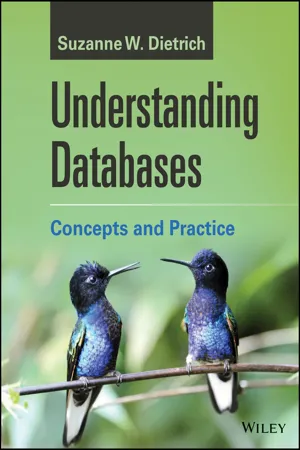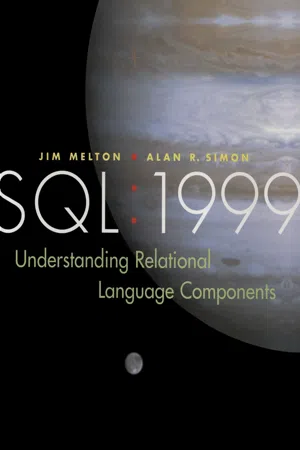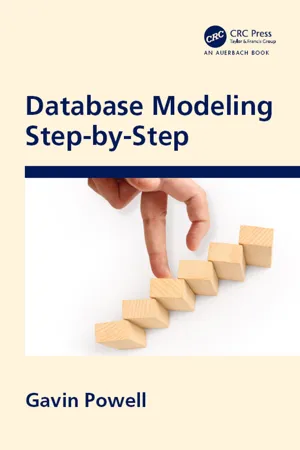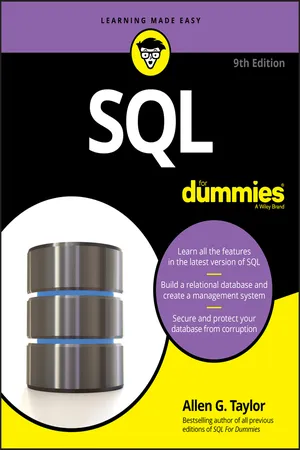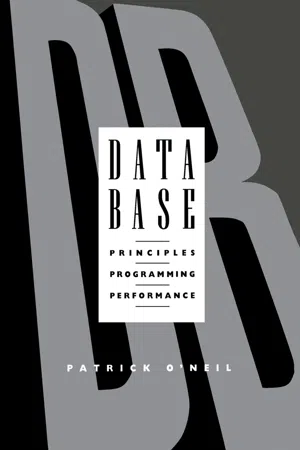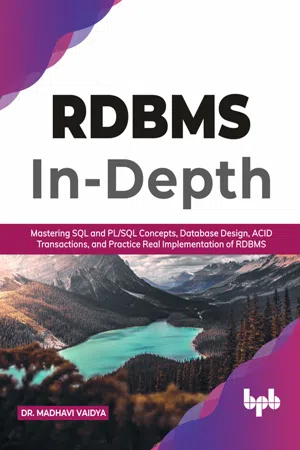Computer Science
Create Table SQL
"Create Table SQL" is a command used in SQL (Structured Query Language) to create a new table in a database. It specifies the table name and the columns it will contain, along with their data types and any constraints. This command is essential for defining the structure of a database and organizing data in a meaningful way.
Written by Perlego with AI-assistance
Related key terms
1 of 5
11 Key excerpts on "Create Table SQL"
- eBook - PDF
Understanding Databases
Concepts and Practice
- Suzanne W. Dietrich(Author)
- 2021(Publication Date)
- Wiley(Publisher)
The SQL DDL specifies the syntax to create, drop, and alter tables. The SQL standard provides a sublanguage for defining a database, called a data definition lan- guage (DDL). There is a create table statement to define the table attributes with the associated types and constraints, along with any constraints that apply at the table level. Once a table is cre- ated, there is support to drop or alter a table’s definition. In addition, the DDL supports the ability to define data structures known as indexes to improve the performance of query execution. The create table statement defines tables whose data are stored as facts. There are also virtual tables, called views, whose definition is based on a query specification. The view definition is stored as part of the database in a component called a data dictionary, which stores the metadata (data about the data) in the database. When the view name is referenced, the query specification is materialized for use in the execution of the referencing query. 151 152 SQL: BEYOND THE QUERY LANGUAGE The create table statement defines a table with its attributes, also called columns. Each attribute has a specified type, with the most common types based on character strings and numer- ics. For example, char(length) denotes a fixed-length character string, whereas varchar(length) means a variable-length character string where length is its maximum size. Examples of numeric types include integer, decimal, float, and numeric. (Check the user manual of the database product for the supported types and descriptions of each type.) Each column has an optional default value specification, which is the word default followed by either a literal of the column’s type to use as a default value for population or the word null. - eBook - PDF
SQL: 1999
Understanding Relational Language Components
- Jim Melton, Alan R. Simon(Authors)
- 2001(Publication Date)
- Morgan Kaufmann(Publisher)
Basic Table Creation As we discussed in Chapter 2, Introduction to SQL:1999, relational databases are organized around tables, columns, and rows. All SQL:1999 data manipula- tion statements must operate on tables that have been created by you or some- one else at some prior time. (Technically, that's not quite accurate. Because of SQL: 1999's ability to represent tables as table value constructors [seen in Chap- ter 9, Advanced SQL Query Expressions], many SQL:1999 data manipulation statements can operate on tables in that form instead of on only those tables stored in the database.) SQL:1999 tables are created through the CREATE TABLE statement. The basic CREATETABLE statement requires a list of the names of the columns being created, the data types, and, if applicable, sizes of values within each column, in addition to other related aspects (such as whether or not null values are permitted). We'll explore the many alternatives of CREATE TABLE and other aspects of data defi- nition in Chapter 4, Basic Data Definition Language (DDL)'; our purpose here is 62 Chapter 3 Basic Table Creation and Data Manipulation to create several simple tables with which we can examine the effects of basic data manipulation statements. A quick word on SQL: 1999 syntax: In general, SQL: 1999 is a free-format lan- guage. Statements may be divided among multiple lines for readability, spaces may be used liberally to offset words from one another, and the use of uppercase or lowercase letters is normally not significant (but there are exceptions covered elsewhere in this book); parentheses may often be used as well to improve under- standing of, and sometimes control, the order in which portions of a statement are grouped and processed. In our sample database application, there are several tables that deal with vid- eotapes and DVDs. - Nong Ye, Teresa Wu(Authors)
- 2014(Publication Date)
- CRC Press(Publisher)
The corresponding terms will be used interchangeably. In addition, uppercase is used for the SQL statements. However, most databases now accept both uppercase and lowercase. 8.3.1 SQL Data Definition Language and Data Types The main SQL command for data definition is the CREATE statement, which can be used to create schemas, tables (relations), and domains. 8.3.1.1 CREATE SCHEMA An SQL schema includes an authorization identifier to indicate the user or account who owns the schema, as well as descriptors for each element in the schema. It is identified by a schema name. These elements include tables, views, and domains that describe the schema. The earliest version of SQL did not include the concept of a relational database schema. All tables are considered to be part of a single schema. In SQL2, a schema was first introduced intending to group tables that belong to the same database application together. To create a schema, the syntax is CREATE SCHEMA schemaname [ AUTHORIZATION username ] [ schema _ element […]] The schemaname is the name for the schema. The AUTHORIZATION command is optional and is used to specify the user, username , who owns the schema. The schema_ element statement declares an optional list of elements (e.g., table, view). Example 8.1 Create a schema named “myschema”: CREATE SCHEMA myschema ; Example 8.2 Create a schema for user Joe: CREATE SCHEMA myschema AUTHORIZATION joe 154 Developing Windows-Based and Web-Enabled Information Systems Note: These two examples illustrate creating simple schemas. We will discuss the syn-tax of adding element descriptors for the schema when we learn how to create views, domains, and tables. 8.3.1.2 CREATE VIEW The CREATE VIEW statement creates a new database view, which is an SQL query stored in the database. The syntax for creating a view is CREATE VIEW viewname [(column-list)] AS query [ WITH [ CASCADED | LOCAL |] CHECK OPTION ] The viewname statement is the name for the new view.- eBook - ePub
- Gavin Powell(Author)
- 2020(Publication Date)
- Auerbach Publications(Publisher)
This chapter shows how the relational database model is used from an application perspective. There is little point in understanding something such as relational database modeling without seeing it applied in some way, and so this chapter looks at how a database model is accessed by applications. A relational database model contains tables, where rows in tables are accessed using a computer programming language called Structured Query Language (SQL). SQL is a declarative programming language that is used to read data from tables and update data in those tables.A declarative programming language describes what you are coding without describing how the problem is solved, which can be difficult to understand, because declarative code requires all instructions in a single complex instruction. Other computer programming languages such as C and FORTRAN are procedural or modular and break software down into separate parts called modules; and then there is Java, which is object-oriented.When a database model is well designed, the creation of SQL code can be a simpler process, which also can imply that difficulties encountered in coding of SQL queries can often indicate database model design flaws, or just too much granularity in a data model.This chapter covers:• What SQL is • The origins of SQL • Different types of queries • Changing data in tables • Changing table structureSQL is a declarative computer programming language used for accessing row and column values in relational database tables:4.1 What is SQL?
• SQL is structured in the sense that it is used to access structured data from tables in a relational database. • Use of the word “language” implies a computer programming language that has specific syntax for performing specific tasks.• SQL is a declarative language consisting of single commands where the database itself does a lot of the work in deciding how to get that information. In other words, SQL tells the database what it wants, and the database does some of the logical assessment, because logic is built into a relational database using keys and relationships between tables. A procedural language, on the other hand, contains blocks of commands, where those blocks of commands are sequences of distinct steps, typically where each successive step is dependent on the result of the previous step (command) in the sequence. - eBook - ePub
- Bryan Newsome(Author)
- 2012(Publication Date)
- Wrox(Publisher)
The database engine, in your case Microsoft SQL Server 2012, manages the file or files and the data within those files. The database format is known as a relational database. At its most basic level, data is stored in tables, rows, and columns similar to how you see data in a spreadsheet. The data in tables is related by special database keys, which allows for better storage and faster retrieval. To access the data, you will use Structured Query Language (SQL). After you complete this chapter, you'll understand all this information. Database Tables A table contains a collection of data, which is represented by one or more columns and one or more rows of data. Imagine the way data is stored in a spreadsheet in rows and columns. Each column in a table represents an attribute of the data stored in that table. For example, a column named First Name would represent the first name of an employee or customer. This column is an attribute of an employee or customer. A row in a table contains a collection of columns that form a complete set of attributes of one instance of the data stored in that table. For example, suppose a table contains two columns: First Name and Last Name. These two columns in a single record describe the name of that one person. This is illustrated in Figure 15.1. Figure 15.1 Try It Out: Creating Tables In this Try It Out, you use SQL Server Management Studio (SSMS) to create a database and add a table. Note SQL Server Management Studio is a tool you use to help manage SQL Server Databases. As a developer, you may or may not have access to your company's SQL Server databases. If you are allowed to access them, this is the best tool to use. It allows you to create and change databases you are using in your applications as well as to create and test SQL statements you will use in your application. There are many other features this application can do for you to help manage your databases that you will not use in this book - eBook - ePub
- Bryan Newsome(Author)
- 2015(Publication Date)
- Wrox(Publisher)
The database engine, in your case Microsoft SQL Server 2014, manages the file or files and the data within those files. The database format is known as a relational database. At its most basic level, data is stored in tables, rows, and columns similar to how you see data in a spreadsheet. The data in tables is related by special database keys, which allows for better storage and faster retrieval. To access the data, you will use Structured Query Language (SQL). After you complete this chapter, you’ll understand all this information. Database Tables A table contains a collection of data, which is represented by one or more columns and one or more rows of data. Imagine the way data is stored in a spreadsheet in rows and columns. Each column in a table represents an attribute of the data stored in that table. For example, a column named First Name would represent the first name of an employee or customer. This column is an attribute of an employee or customer. A row in a table contains a collection of columns that form a complete set of attributes of one instance of the data stored in that table. For example, suppose a table contains two columns: First Name and Last Name. These two columns in a single record describe the name of that one person. This is illustrated in Figure 12.1. FIGURE 12.1 TRY IT OUT Creating Tables In this Try It Out, you use SQL Server Management Studio (SSMS) to create a database and add a table. NOTE SQL Server Management Studio is a tool you use to help manage SQL Server Databases. As a developer, you may or may not have access to your company’s SQL Server databases. If you are allowed to access them, this is the best tool to use. It enables you to create and change databases you are using in your applications, as well as to create and test SQL statements you will use in your application. There are many other features this application can do for you to help manage your databases that you will not use in this book - eBook - ePub
Learn T-SQL From Scratch
An Easy-to-Follow Guide for Designing, Developing, and Deploying Databases in the SQL Server and Writing T-SQL Queries Efficiently
- Brahmanand Shukla(Author)
- 2021(Publication Date)
- BPB Publications(Publisher)
HAPTER 2Tables
D ata in SQL Server and other relational databases are stored in tables in the form of rows and columns. The table is the starting point of any relational database. We can’t query data unless we’ve tables.In this chapter, we’ll learn more about tables to create, modify, and delete them. We’ll also learn about various other supporting features used while dealing with tables in SQL Server.We’ve learned about the SSMS in Chapter 1, Getting Started . It is an advanced tool shipped with Graphical User Interface (GUI) to create, modify, and delete the tables and other objects in SQL Server. You can do almost everything using GUI that you can do with T-SQL scripts. However, in this book, we’ll only use T-SQL.Structure
In this chapter, we will cover the following topics:- CREATE DATABASE
- USE DATABASE
- CREATE SCHEMA
- Data types
- CREATE TABLE
- Three-part naming
- ALTER TABLE
- DROP TABLE
- What is NULL?
- Primary Key constraint
- NOT NULL constraint
- UNIQUE constraint
- Primary Key versus UNIQUE constraint
- DEFAULT constraint
- CHECK constraint
- Foreign Key constraint
- CASCADING in Foreign Key
CREATE DATABASE
Since we are going to learn tables in this chapter. Hence before we create the table, it’s mandatory to have a database that will hold the tables and other SQL Server objects.Quoting here an important learning from Chapter 1, Getting Started .You can’t create the table without the database. The table has to be created within a database. The database is the placeholder for tables and other database objects. T-SQL is easy to understand language. The commands are simple and similar to giving general instructions.A database can have multiple file groups. A file group can have multiple data files. A data file can have multiple schemas. A schema can have multiple tables/objects. A table can have multiple partitions. A partition can have multiple rows and each row can have multiple columns. A page can hold one or more rows. - eBook - ePub
- Allen G. Taylor(Author)
- 2018(Publication Date)
- For Dummies(Publisher)
You must know what you’re doing at the outset; figuring things out along the way can lead to less-than-desirable database results. You must enter the entire CREATE TABLE statement before SQL even looks at it, let alone gives you any indication of whether you made errors in the statement. In ISO/IEC standard SQL, the statement that creates a proposal-tracking table (identical to the one created earlier in the chapter) uses the following syntax: CREATE TABLE POWERSQL (ProposalNumber INTEGER PRIMARY KEY, FirstName CHAR (15), LastName CHAR (20), Address CHAR (30), City CHAR (25), StateProvince CHAR (2), PostalCode CHAR (10), Country CHAR (30), Phone CHAR (14), HowKnown CHAR (30), Proposal CHAR (50), BusinessOrCharity CHAR (1)); The information in the SQL statement is essentially the same information you enter using Access’s graphical user interface. The nice thing about SQL is that the language is universal. The same standard syntax works regardless of what standard-compliant DBMS product you use. In Access 2016, creating database objects such as tables is a little more complicated. You can’t just type a CREATE statement (such as the one just given) into the SQL View Object tab. That's because the SQL View Object tab is available only as a query tool; you must take a few extra actions to inform Access that you’re about to enter a data-definition query rather than a normal query that requests information from the database. A further complication: Because table creation is an action that could possibly compromise database security, it’s disallowed by default - eBook - PDF
Database
Principles Programming Performance
- Patrick O'Neil(Author)
- 2014(Publication Date)
- Morgan Kaufmann(Publisher)
Thus every command of the form given in (3.2.2) begins with the words create table . . . , while the word table-name is not literally entered and should be filled in with a desired table name, such as c u s t o m e r s . A phrase in braces, { . . . } , may occur zero or more times. This implies that the syntax given in (3.2.2) requires a table to have one or more column names, since we see the phrase col umnname d a t a t y p e [ n o t n u l l ] once, and then it is repeated, with an initial sep-arating comma, in braces. (There is actually an upper limit to the number of column names allowed, but this limit is not specified in the syntax and we can ignore it for now.) When a phrase occurs in brackets, [ ], it means that the phrase is optional. Thus we see that the phrase not null may or may not occur following any column name and datatype description. Look at (3.2.1) again as an example of the form specified in (3.2.2). A Practical Exercise If you are using the ORACLE or INGRES database products, you should at this point read Appendix A, which provides a tutorial on the skills you need to set up the CAP database. Even if you are using a different product, Appendix A will give you an idea of the skills required and the sequence of relatively standard Create Table commands you will need. [3.2.3] Create a database, if this has not already been done for you, with dbname consisting of (up to) the first six characters of your login ID, suffixed by the string . . . sql—for example, poneilsql. Next, create and load into your database the tables pictured in Fig-ure 2.2—customers, a g e n t s , p r o d u c t s , and o r d e r s . You should create command procedure files with terminal monitor com-mands to do as much of the work as possible: for example, see the form given by m a k e c u s t s , in Appendix A.l for INGRES, and try to replicate this for additional CAP tables, with the file names 3.3 Simple Select Statements makeagents, makeprods, and makeords. - eBook - ePub
RDBMS In-Depth
Mastering SQL and PL/SQL Concepts, Database Design, ACID Transactions, and Practice Real Implementation of RDBM (English Edition)
- Dr. Madhavi Vaidya(Author)
- 2021(Publication Date)
- BPB Publications(Publisher)
Transaction Control Language (TCL): This is used to commit the transaction or to roll-back the transaction. The transaction is saved after execution or the transaction can be undone.Data definition language
By using this component of SQL, it is possible to create the table. Tables consist of rows and columns. It is also known as an entity in relational DBMS. There are objects, which store the user data. Tables can be permanent or temporary. Syntax for creating a table in SQL is as follows: SQL>create table <tablename> (column1 datatype(size), column2 datatype(size)); A table can have a maximum of 1000 columns. Only one column of type LONG is allowed per table. SQL>create table student(rolno number(3),name varchar(10),total long,avg1 long) * ERROR at line 1: ORA-01754: a table may contain only one column of type LONG Actual query can be interpreted as follows: SQL>create table student(rollno number(3),name varchar(10),test_marks number(2));Constraints
Constraints implemented on a table: Data integrity is one of the very important functions of DBMS.In this query we have seen how the data types are used. Following are the data types used while creating table: Data types supported in SQL:Data Type Description Char(n) To store fixed length string. Max length = 2000 bytes. For example. Name char(15) Varchar2(n) To store variable length string. Max length = 4000 bytes. For example, Remark varchar(100) Long(n) To store variable length string. Max length = 2 GB. For example, Project_doc long(5000) Number(p, s) To store numeric data. Max number of significant digits = 38 For example, Salary number(9,2). The meaning of this (9,2) is that the total number of bytes will be 9. They will be placed as 7 digits before decimal point & 2 digits after decimal point. Date To store Date data: Both date and time can be stored. For example, Hiredate Date. Generally, the value in date in stored in ‘dd-mon-yy’ format - eBook - ePub
Learning PostgreSQL 11
A beginner's guide to building high-performance PostgreSQL database solutions, 3rd Edition
- Salahaldin Juba, Andrey Volkov(Authors)
- 2019(Publication Date)
- Packt Publishing(Publisher)
SQL Language
Structured Query Language (SQL ) is used to set up the structure of the database, to manipulate the data in a database, and to query the database. This chapter is dedicated to the Data Manipulation Language (DML ) that is used to create data in a database, change or delete it, and retrieve it from the database.After reading this chapter, you will understand the concept of SQL and the logic of SQL statements. You will be able to write your own SQL queries and manipulate data using this language. A complete reference for SQL can be found in the official PostgreSQL documentation at http://www.postgresql.org/docs/current/static/sql.html .The topics that we will cover in this chapter are as follows:- SQL fundamentals
- Lexical structure
- Querying data with SELECT statements
- Changing data in a database
The code examples in this chapter are based on the prototype of a car portal database described in the previous chapters. The scripts to create the database and fill it with sample data can be found in the attached media. They are called schema.sql and data.sql. All of the code examples from this chapter can be found in the examples.sql file.Refer to Chapter 2 , PostgreSQL in Action , for details on how to use the psql utility.Passage contains an image
SQL fundamentals
SQL is used to manipulate the data in a database and to query the database. It's also used to define and change the structure of the data—in other words, to implement the data model. You already know this from the previous chapters.In general, SQL has three parts:- Data Definition Language (DDL )
- DML
- Data Control Language (DCL )
The first part is used to create and manage the structure of the data, the second part is used to manage the data itself, and the third part controls access to the data. Usually, the data structure is defined only once, and then it's rarely changed. However, data is constantly inserted into the database, changed, or retrieved. For this reason, the DML is used more often than the DDL.
Index pages curate the most relevant extracts from our library of academic textbooks. They’ve been created using an in-house natural language model (NLM), each adding context and meaning to key research topics.
